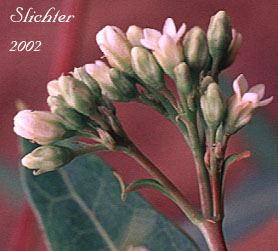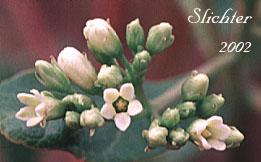 The
photo at right shows the upright nature of the stems of hemp dogbane and the short
petioles on the upper leaves. Photographed on slopes above the North Fork of the
Sun River, Montana........July 31, 1999.
The
photo at right shows the upright nature of the stems of hemp dogbane and the short
petioles on the upper leaves. Photographed on slopes above the North Fork of the
Sun River, Montana........July 31, 1999.
Hemp dogbane, also known as common dogbane is an erect perennial wildflower with simple, branched stems ranging from 30-100 cm high. The herbage is generally glabrous, although occasionally it may be hairy. The leaves are opposite with the lower stem leaves subsessile to sessile and the upper leaves with distinct petioles. The leaves are often a yellowish-green color and are ascending to erect. They are oblong-ovate to oblong-lanceolate or even lanceolate in shape, and range from 5-11 cm long.
The inflorescence is either a terminal or lateral cyme. The whitish to greenish-white flowers are 2-4 mm long with short tubes and 5 lobes, each of which is lanceolate to oblong-oblanceolate with pointed tips. The corolla lobes are somewhat spreading as seen in the photo above. The 5 calyx lobes range from about half to nearly equal to the length of the corolla. The fruits are long, thin, somewhat sickle-shaped follicles, ranging from 12-18 cm long. The follicles droop.
Hemp dogbane was an important source of cordage for Native Americans. Dogbanes are generally poisonous and not safe for human consumption.
Similar Species:Hemp dogbane is similar in appearance to clasping-leaved dogbane (Indian hemp), Apocynum sibiricum. The latter species can be most reliably distinguished from the former as all of its leaves have clasping bases.
Hemp dogbane is often found near springs, seeps, river banks, and roadside ditches.
Hemp dogbane may be found across much of Canada and the United States.
In the Columbia River Gorge it may be found between the elevations of 0'-300' from near Cape Horn east towards Biggs Junction, OR. -
- 